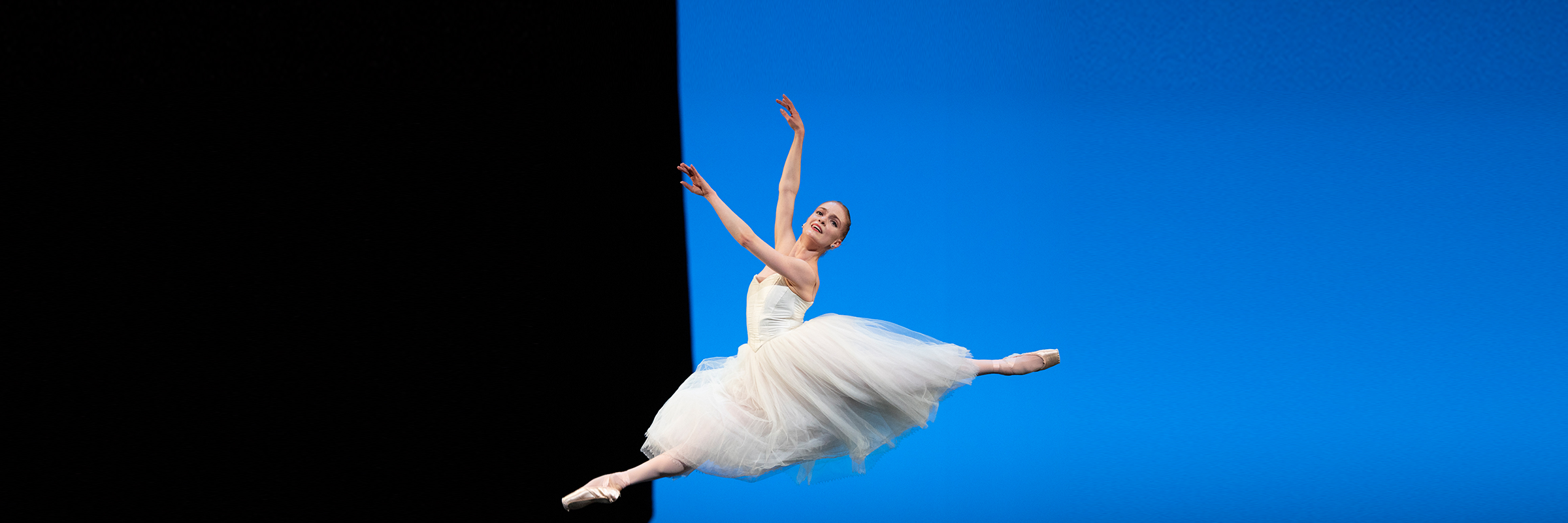About Harald Lander’s Etudes
Etudes transforms dancers’ daily ritual of ballet class.
Etudes, French for “studies,” takes dancers’ prosaic daily ritual—ballet class—and elevates and transforms it for the stage. Designed to gradually warm up muscles and get the body aligned for the day, most ballet classes follow a standard order of exercises that start small and gradually get bigger and more complex. These same movements, even the smallest pliés and tendus, are the building blocks from which classical ballets are constructed. Etudes illuminates these classroom exercises, then illustrates how these simple steps can become art.

Etudes was choreographed in 1948 by Harald Lander, a Danish-born dancer and artistic director of the Royal Danish Ballet. The initial inspiration came from composer Knudåge Riisager. On an autumn afternoon in Copenhagen, as he watched a swirl of fall leaves, Riisager heard through a window someone practicing a Carl Czerny piano exercise. He decided to orchestrate the music for a ballet, brought the score to Lander, and the concept for Etudes was born.
Etudes was a departure for the Royal Danish Ballet, which at the time of the premiere, performed mostly narrative works. By 1948 George Balanchine had introduced American audiences to abstract ballet, but it wasn’t yet as common in Denmark. As artistic director, Lander revitalized the Royal Danish Ballet. He both created new work and restored its heritage—the work of August Bournonville, its longtime director during the mid-1800s. Bournonville established the company’s characteristic style of seemingly effortless jumps, quick footwork, and simple rounded arms. Although Etudes is a more abstract work, Bournonville’s style infuses parts of Lander’s ballet like a soft perfume.

Lander continued to update Etudes after the premiere, revising it for performances in Denmark in 1951, and again in 1952 for Paris Opera Ballet, when he was directing that company. He added increasingly challenging steps as well as expanded roles for three lead dancers. Landers revised the ballet a final time for a Danish television recording in 1969. Dancing in the corps de ballet for that recording was Johnny Eliasen, who came to SF Ballet to stage the work last fall.
The curtain rises on dancers doing traditional exercises at the barre, with a twist. Only the lower half of the dancers are illuminated, the rest of the stage is black. The effect is a kaleidoscopic vision of two dozen disembodied limbs moving crisply through ballet steps. The “black barre” exercises may be simple, but the exacting coordination required to synchronize them is anything but. “It’s a beautiful nightmare,” says Eliasen. “It has to be so precise. There’s only one way [to learn it]—just repeat and repeat.”

The ballet progresses to more and more expansive steps as the dancers leave the barre. It then shifts gears with an homage to the sylphs (mythological air spirits) of 19th-century Romantic ballet. The Bournonville ballet La Sylphide is central to the Royal Danish Ballet’s heritage, and this section of Etudes draws from the same well. “How we use our arm, how we use our hands—it can be difficult for companies that haven’t done Bournonville [ballets],” says Eliasen. While he tries to help dancers become fluent in the Danish style (particularly by taking time to teach that same daily ritual of company class), Eliasen also appreciates a regional accent. “It’s important they know the steps and the musicality and hopefully the right arms,” he says. “But each company should have its own identity.”

To perform Etudes requires a deep bench; in addition to three leading roles, there’s a 36-member corps de ballet that’s essential to the ballet’s success. “It’s like a watch,” says Eliasen. “There are three hands. But the hands only work if what’s behind them works.”
Lander packed an enormous amount of dancing into the 40 minutes of Etudes, much of it for the corps de ballet. Part of what has made the ballet such an enduring audience favorite is the irresistible thrill of seeing so many dancers moving at full velocity completely in sync. Etudes culminates with one of the most thrilling displays of turns and jumps in ballet. “It’s brilliantly constructed,” says Eliasen. “The buildup of music at the end is so exciting. People everywhere love it.”

Program Notes by Caitlin Sims
Header image: Sasha De Sola in Lander’s Etudes // © Erik Tomasson



